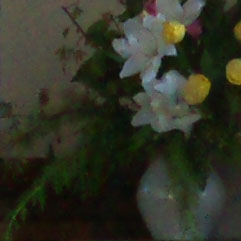Sony Alpha DSLR-A900
-
-
Written by Gordon Laing
Sony Alpha DSLR-A900 vs Canon EOS 1Ds Mk III vs Nikon D700 High ISO Noise
Sony Alpha DSLR-A900 results : Outdoor resolution / Studio resolution / High ISO Noise / Noise Reduction
Sony Alpha DSLR-A900 results continued…
Outdoor resolution / Studio resolution / High ISO Noise / Noise Reduction
 |
 | To compare noise levels under real-life conditions we shot this scene with the Sony Alpha DSLR-A900, Canon EOS 1Ds Mark III and Nikon D700 within a few moments of each other using each of their ISO settings. High ISO Noise Reduction was set to Normal, Off and Normal on each body respectively. The A900’s Dynamic Range Optimizer and the D700’s Active D-Lighting were disabled. The respective lenses (named above the samples) were adjusted to deliver the same vertical field of view and set to f8 for optimum sharpness. |
The image above was taken with the Sony Alpha DSLR-A900 at a sensitivity of 100 ISO, using the Sony Carl Zeiss 24-70mm f2.8 lens at 24mm f8; the original Large Super Fine JPEG file measured 12.8MB. The crops are taken from the centre and presented at 100%. The Canon EOS 1Ds Mark III and (especially the) Nikon D700 crops show a larger area due to their lower resolutions.
The Canon EOS 1Ds Mark III kicks-off the sequence with a very clean and detailed result at its expanded low setting of 50 ISO. Stepping up a notch to 100 ISO, all three bodies unsurprisingly deliver good, clean images, although at 200 ISO, the Sony A900 has the very slightest hint of chroma noise in the background – that’s serious pixel-peeping though.
At 400 ISO though, this coloured patchiness has become more apparent on the Sony crop, while the Canon and Nikon remain pretty clean. At 800 and 1600 ISO, all three bodies are showing steadily increasing amounts of noise, but the Sony A900 is suffering more, especially as its High ISO Noise Reduction kicks-in at 1600 ISO and smears-out much of the fine detail.
At 1600 and 3200 ISO, the Canon and Nikon bodies are delivering preferable output to the Sony, and while both exhibit more noticeable noise speckles, noise reduction in post-processing should still deliver a better-looking result.
At 3200 and 6400 ISO, the Nikon D700 despite having half the number of Megapixels, is recording greater detail than the Sony A900, but at 12800 and especially 25600 ISO, the D700’s quality really deteriorates with a significant rise in speckles and loss of saturation. Also remember if you’re reproducing images from all three bodies at the same size, any artefacts from the D700 will appear bigger due to its lower resolution.
As for the two very high resolution models, the Sony and Canon may deliver roughly similar results up to 200 ISO, but at 400 ISO and especially 800 ISO and above, the Canon has the edge. Smearing can be reduced on the A900 though at 1600 ISO and above by switching off its High ISO Noise Reduction, and you can see examples of this on the next page. So check out our Sony A900 Noise Reduction results, or alternatively head straight to our Sony A900 Gallery for more real-life sample images across its sensitivity range.
Sony Alpha DSLR-A900 with Sony Carl Zeiss 24-70mm |
Canon EOS 1Ds Mark III with Canon EF 24-105mm IS |
Nikon D700 with Nikkor AF-S 14-24mm | ||
 |
 |
 | ||
50 ISO not available |
Lo (50 ISO) |
50 ISO not available | ||
 |
 |
 | ||
100 ISO |
100 ISO |
Lo 1 (100 ISO) | ||
 |
 |
 | ||
200 ISO |
200 ISO |
200 ISO | ||
 |
 |
 | ||
400 ISO |
400 ISO |
400 ISO | ||
 |
 |
 | ||
800 ISO |
800 ISO |
800 ISO | ||
 |
 |
 | ||
1600 ISO |
1600 ISO |
1600 ISO | ||
 |
 |
 | ||
3200 ISO |
Hi (3200 ISO) |
3200 ISO | ||
 |
 |
 | ||
6400 ISO |
6400 ISO not available |
6400 ISO | ||
 |
 |
 | ||
12800 ISO not available |
12800 ISO not available |
Hi 1 (12800 ISO) | ||
 |
 |
 | ||
25600 ISO not available |
25600 ISO not available |
Hi 2 (25600 ISO) |




